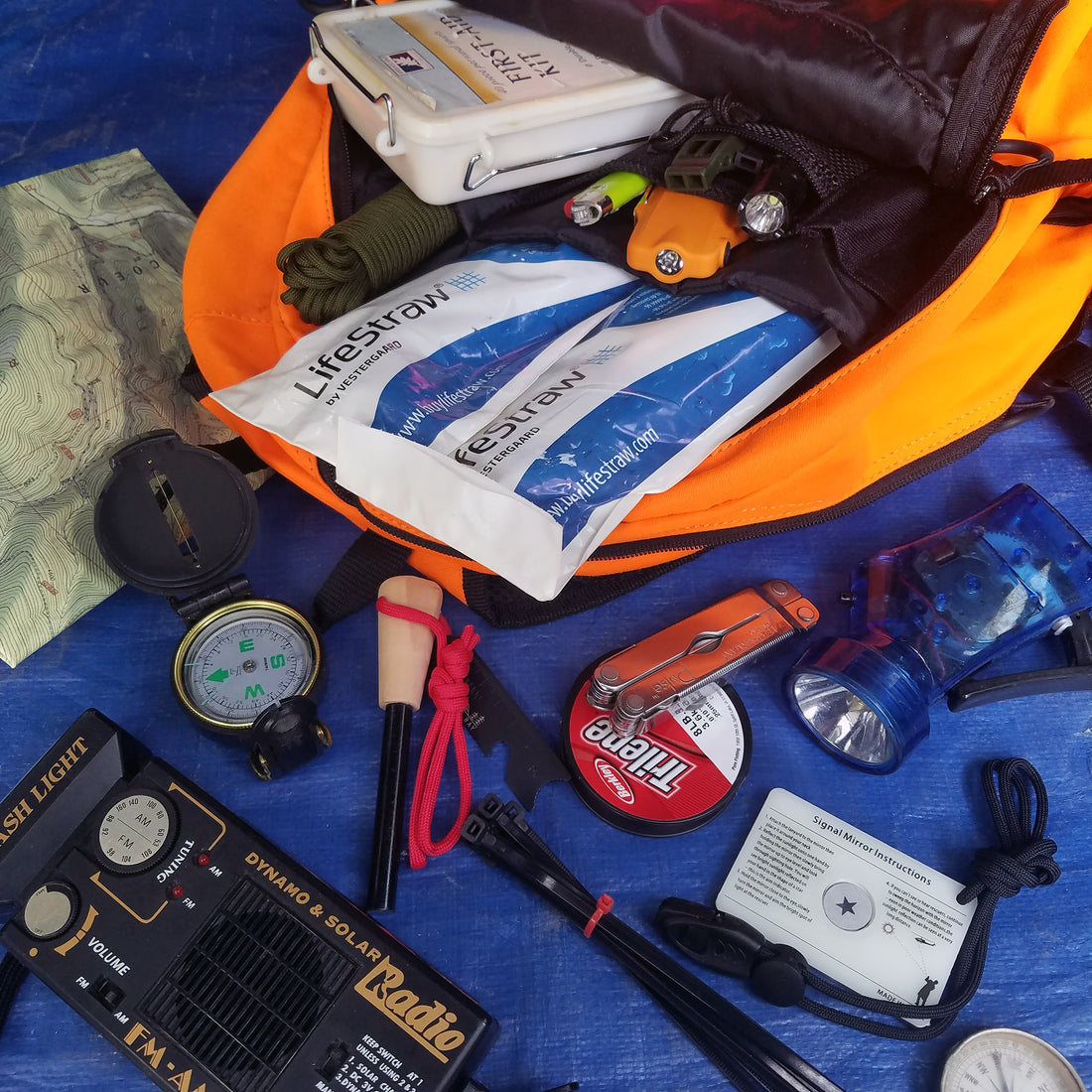
Putting Together an Emergency Bugout Bag
Share
Two of the most valuable lessons I learned from my parent as a youth were the importance of "being prepared" and that "life is not fair". Inevitably, bad things will occur throughout your life at the most inopportune times that you'll need to deal with when they occur, and with what you have. That’s why I like to have a bugout bag at the ready. What is a bug-out bag? In simple terms, it is a prepacked bag of essential tools and supplies that can be grabbed at a moment’s notice that will help you get through a major emergency situation.
Being prepared is nothing more than realizing something could happen that would put you in an uncomfortable situation and, with that in mind taking steps to help you successfully navigate the situation. Survival Preparation can mean a lot of different things to different people, but the common thread which ties them all together is PLANNING.
The process of putting together an emergency bugout bag not only results in a package of tools and supplies that can help you get through a bad situation if it arises but also serves as a valuable mental exercise of what-if? Bad situations are much more manageable to deal with if you’ve already worked through the what-ifs ahead of time.
How much you put into your kit depends on the purpose/location of the kit. Below is the kit that I’ve together as my home “bugout bag”. I keep this bag readily accessible in my closet so that I can grab it at a moment’s notice. This could be a wildfire, storm, or one of many other disasters that could require myself or my family to flee for our safety. There's no right or wrong when it comes to putting together your kit as long as you've reasonably thought things out and have addressed situations that you feel you may encounter.
The following is what I include in MY personal bug-out bag. The total weight of the bag is under 12 lbs which is a good manageable size for me. Again, this is our families kit. You may identify items you want to add or drop and that’s OK. To keep things fresh, I also make it a point to go through my bag a couple of times each year to review its contents and possibly ad any new items that I’ve come across.
The Pack – I use a simple medium-sized backpack (30L) constructed from nylon. You might consider something with a bright color to help it stand out. I recommend looking for one with a single carry strap/handle at the top so it’s easy to grab and go. A few exterior pockets are nice, but you want to keep it relatively simple and streamlined so it doesn’t get hung up on everything while you’re on the move. A duffle bag or suitcase or dry bag are options; however, I prefer the hands-free feature of a backpack.
Pocket Knife - My choice is a Leatherman multi-tool. Along with a cutting blade, there are also pliers, file screwdrivers, etc. It's the closest you'll get to having a toolbox in your kit.
Blanket – Because space is limited in my pack, I include two of the small packaged mylar survival blankets that can provide some protection from the elements either as blankets or shelters.
First Aid – I include a basic first aid kit in a plastic case with an assortment of band-aids, pain relievers, antibiotic ointment, etc. (You should also consider whether anyone in your family requires any special medication that you may want to include)
Fire-starting – Waterproof matches or lighter are good choices. You'll need this to light candles, start a signal fire, or campfire for heat. I also include a ferro rod and tinder as a fail-safe backup.
Candles – To provide light in the darkness I include a couple of the small stubby ones, so they won’t easily fall over.
Flashlight – I prefer the type that is dynamo/crank powered so I don’t have to worry about batteries. I’ve also recently added a small rechargeable LED headlamp that provides hands-free use.
Solar Charger – This is a new item I’ve recently added. We’ve become so dependent on our electronics and mobile phones, that having a renewable charging source is super valuable. The unit I use has a battery pack with fold-out solar charging panels and can be used to charge various electronic devices.
Small AM/FM radio – The one I use has a solar charging panel as well as a dynamo crank, so I don't have to rely on batteries.
Water - My go-to is a couple of the LifeStraw personal water filters, but purification tablets or drops would suffice. I also keep two full plastic bottles of water that can be refilled/purified using the items above.
Map & Compass – I like to keep both a US map and a local map of my area along with a compass for basic navigation. Although I know my area very well, having a map is imperative for planning and communicating your movements with others.
Signaling – In order to be more visible to search and rescue operations, I include a small signaling mirror along with two whistles. You could find yourself stranded on a rooftop in a flood area or trapped under rubble following an earthquake and having these items can make you easier to locate.
Food – I personally don’t include any food items in my bag that could be perishable. Instead, I include a few fishhooks/lures along with a small spool of fishing leader. Fish are abundant in streams, ponds, and lakes across the country and are a relatively easy source of food to acquire.
Sewing Kit – A very small kit with a needle and some thread can be used for clothing/gear repair and could potentially be used to stitch wounds in a worst-case scenario.
Towels – I like to have a couple of microfiber towels or rags on hand for general uses.
Rope/Cordage – I like a 25-foot “hank” of 550 Paracord that be used for numerous tasks and repairs. The extra benefit of paracord is in its construction. There are 7 inner strands that can be removed used for smaller tasks.
Duct Tape – No surprise here. My choice is a smaller roll in a high visibility pink color.
Binoculars – A compact and inexpensive 10x set can be handy for spotting features or things in the distance.
Personal Hygiene – Little things like a toothbrush and a bar of soap can do a lot for your mental well-being when things are tough.
Clothing – An extra pair of socks for use in case you get wet and can also act as mittens to keep your hands warm. A wool beanie is another lightweight item that can be valuable for keeping warm.
Harmonica – This one might sound odd, but they say the quiet silence that occurs in isolated survival situations can be very disconcerting to some. A harmonica can provide some semblance of “music” that can be comforting. Credit this suggestion to Les Stroud aka "Survivorman" on this one.
Notebook – A small notebook and pencil are great to have on hand for making lists, a journal, and leaving notes. The one I use is an outdoor notebook with specially coated paper that holds up under damp conditions.
Misc Items – These are just a few random items that don’t have a specific use or intention but I feel could be valuable resources. I take a large ziplock baggie and place the following items in it. (1) large plastic trash bag, folded up flat. (1) 24” of aluminum foil, folded up flat. (4) rubber bands. (10) plastic zip ties.
Firearm – I keep a locked pistol in my bag along with a box of ammo. I choose a small frame revolver for its simplicity and stick with a common caliber (.357) to increase my chances of acquiring more in a pinch. I realize not everyone is comfortable with firearms, however in a really bad situation I want to be able to defend my family and consider it a necessity, so I’ve taken the time to become properly trained.
The following are not in my bag but might be good ideas in other regions or situations: snakebite kit, sunblock, chapstick, sunglasses, hatchet.

1 comment
Great blog! Very informative no matter your experience level. Thank you!